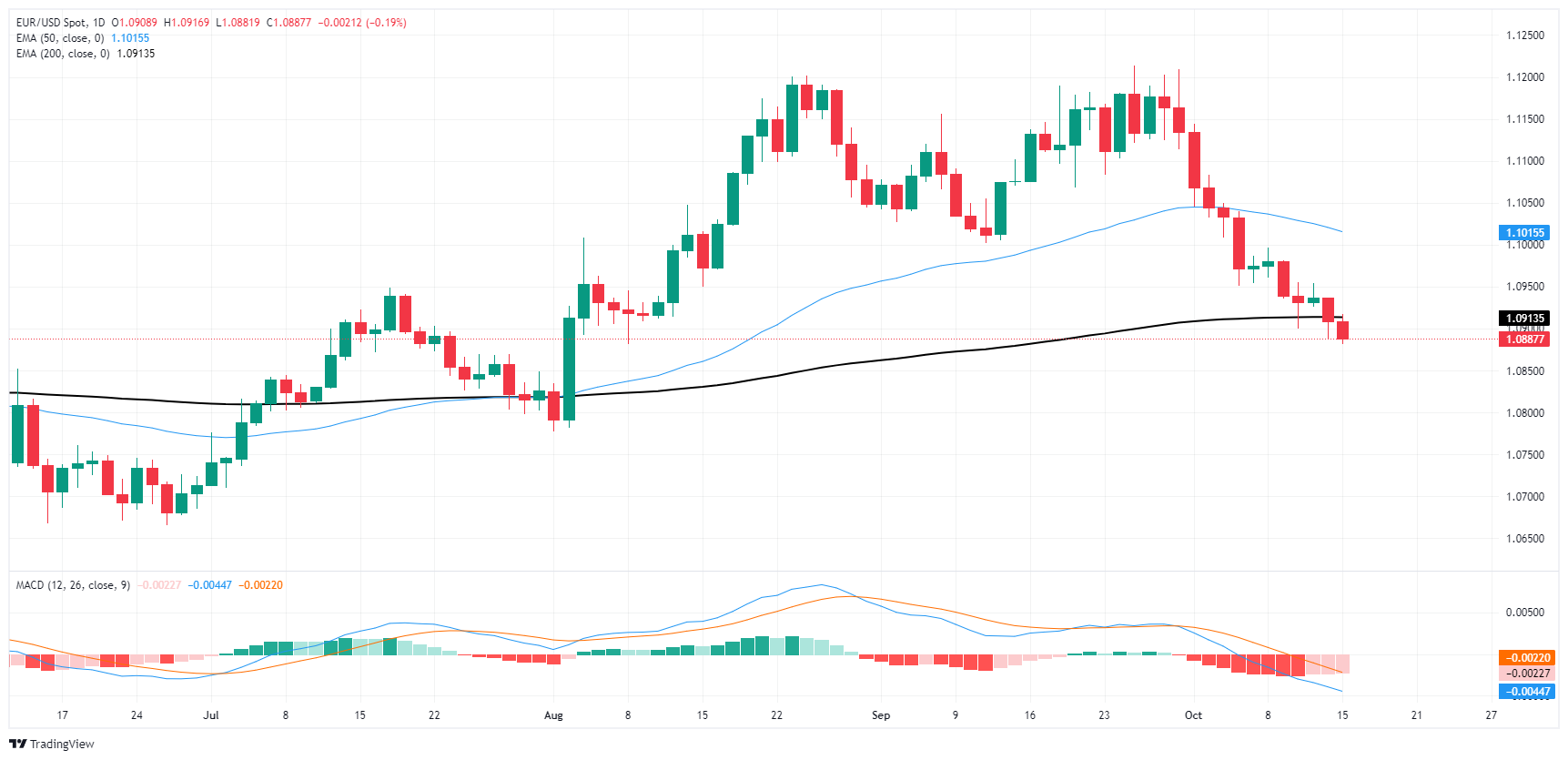EUR/USD extends decline as ECB rate call looms ahead

- EUR/USD shed another fifth of a percent on Tuesday.
- ECB Bank Survey results trimmed bullish Euro potential.
- ECB broadly expected to deliver another 25 bps rate cut this week.
EUR/USD fell further into the bearish side on Tuesday, declining one-fifth of one percent and slipping below the 200-day Exponential Moving Average (EMA). Price action closed below the 1.0900 handle for the first time since early August. Fiber has now fallen nearly 3% from late September’s peaks just north of the 1.1200 handle.
European banks broadly reported negative repercussions from the European Central Bank’s (ECB) summertime rate cut, with EU-area banks reporting that while credit standards have remain unchanged overall and actually eased for loans to households, consumer credit conditions remain tight. A rebound in housing loan demand is riding exclusively on anticipation of further rate cuts, implying consumers are over-borrowing in the near-term, while EU bank net interest income as a result of ECB policy rate decisions has turned negative for the first time since 2022.
The ECB’s upcoming rate call on Thursday is broadly expected to be a quarter-point rate trim on the main deposit rate with markets widely forecasting a 25 bps rate cut, while the ECB main refi rate is expected to get trimmed by a similar 25 bps to 3.4% from 3.65%.
Elsewhere on the Fiber data docket, US Retail Sales figures for September are slated for Thursday’s US market session. US Retail Sales are expected to rebound for the month of September, forecast to rise to 0.3% MoM from the previous 0.1%.
EUR/USD price forecast
EUR/USD has slid back below the 200-day EMA and lost hold of the 1.0900 handle. The pair has closed in the red for all but three of the last 12 consecutive trading days. Oversold warnings on the Moving Average Convergence-Divergence (MACD) implies that near-term short momentum on Fiber may have run its course, leaving the pair primed for a bullish rebound from the 200-day EMA.
EUR/USD daily chart
Euro FAQs
The Euro is the currency for the 19 European Union countries that belong to the Eurozone. It is the second most heavily traded currency in the world behind the US Dollar. In 2022, it accounted for 31% of all foreign exchange transactions, with an average daily turnover of over $2.2 trillion a day. EUR/USD is the most heavily traded currency pair in the world, accounting for an estimated 30% off all transactions, followed by EUR/JPY (4%), EUR/GBP (3%) and EUR/AUD (2%).
The European Central Bank (ECB) in Frankfurt, Germany, is the reserve bank for the Eurozone. The ECB sets interest rates and manages monetary policy. The ECB’s primary mandate is to maintain price stability, which means either controlling inflation or stimulating growth. Its primary tool is the raising or lowering of interest rates. Relatively high interest rates – or the expectation of higher rates – will usually benefit the Euro and vice versa. The ECB Governing Council makes monetary policy decisions at meetings held eight times a year. Decisions are made by heads of the Eurozone national banks and six permanent members, including the President of the ECB, Christine Lagarde.
Eurozone inflation data, measured by the Harmonized Index of Consumer Prices (HICP), is an important econometric for the Euro. If inflation rises more than expected, especially if above the ECB’s 2% target, it obliges the ECB to raise interest rates to bring it back under control. Relatively high interest rates compared to its counterparts will usually benefit the Euro, as it makes the region more attractive as a place for global investors to park their money.
Data releases gauge the health of the economy and can impact on the Euro. Indicators such as GDP, Manufacturing and Services PMIs, employment, and consumer sentiment surveys can all influence the direction of the single currency. A strong economy is good for the Euro. Not only does it attract more foreign investment but it may encourage the ECB to put up interest rates, which will directly strengthen the Euro. Otherwise, if economic data is weak, the Euro is likely to fall. Economic data for the four largest economies in the euro area (Germany, France, Italy and Spain) are especially significant, as they account for 75% of the Eurozone’s economy.
Another significant data release for the Euro is the Trade Balance. This indicator measures the difference between what a country earns from its exports and what it spends on imports over a given period. If a country produces highly sought after exports then its currency will gain in value purely from the extra demand created from foreign buyers seeking to purchase these goods. Therefore, a positive net Trade Balance strengthens a currency and vice versa for a negative balance.
